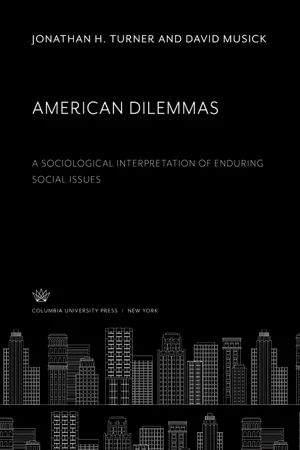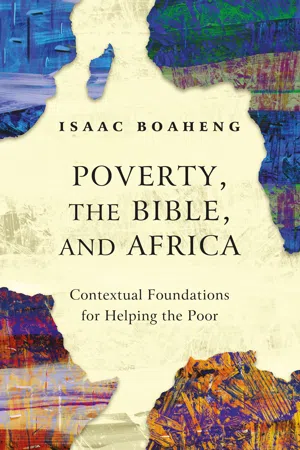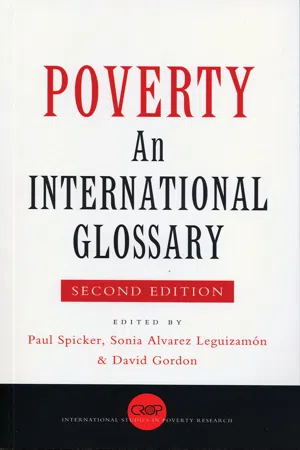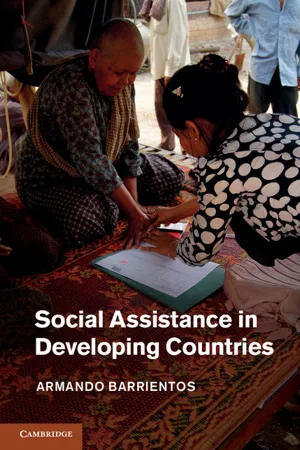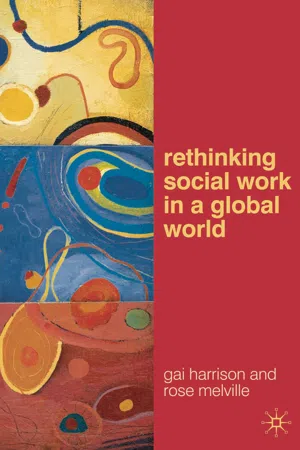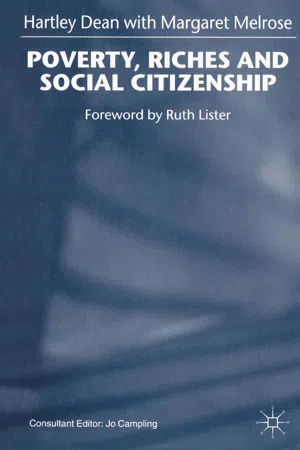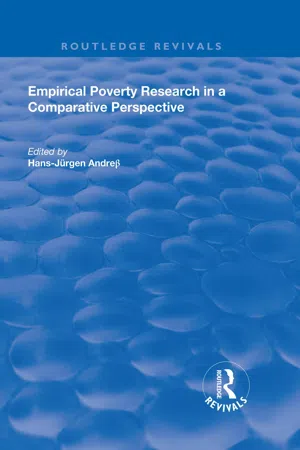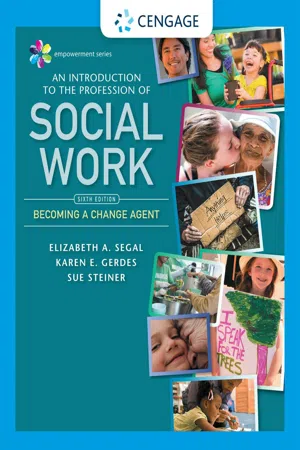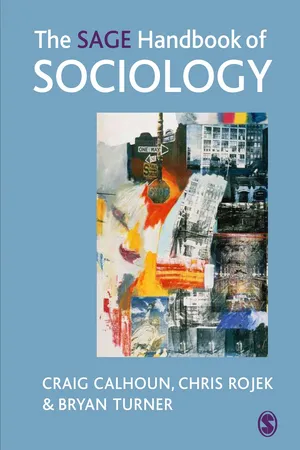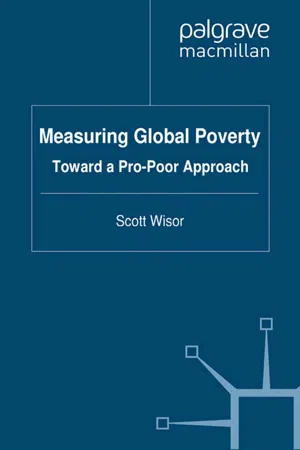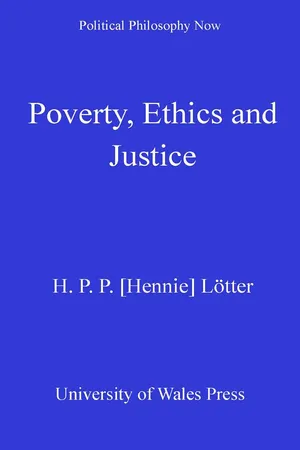Social Sciences
Poverty and Wealth
Poverty and wealth refer to the unequal distribution of resources within a society. Poverty is the condition of lacking basic necessities, while wealth signifies an abundance of resources and assets. These concepts are central to understanding social inequality and economic disparities, and they are often studied in relation to social, political, and economic structures.
Written by Perlego with AI-assistance
Related key terms
1 of 5
12 Key excerpts on "Poverty and Wealth"
- eBook - PDF
American Dilemmas
A Sociological Interpretation of Enduring Social Issues
- Jonathan H. Turner, David Musick(Authors)
- 2019(Publication Date)
- Columbia University Press(Publisher)
Chapter 7 Wealth and Poverty T h e United States probably reveals a large poverty sector. Juxtaposed to such poverty is a relatively small wealth-holding elite. And between these two extremes is a large grouping of middle Americans who enjoy varying degrees of relative affluence. The existence of concentrated wealth and pauperism is not coincidental. One contributes to the other. The persistence of poverty in the midst of affluence has posed an enduring dilemma for Americans. This dilemma must, however, be viewed in the more general context of in-equality. Indeed, one of the great failings of social science is its tendency to analyze poverty per se without at the same time recognizing that the existence of poverty is tied to the dynamics of inequality in America. 1 Inequality can be defined as the differential distribu-tion of those resources that members of a society value. The three most basic resources are (1) material wealth, or the money to buy material goods, (2) power, or the capacity to control others, and (3) prestige, or the honor and esteem that one receives from others. 2 In all but the simplest societies, material wealth, power, and prestige are distributed un- WEALTH AND POVERTY 175 equally. Some get more of these valued resources than oth-ers. Many of the dynamics of a society are inevitably influ-enced by how these resources are distributed. Societies that distribute these resources unequally—where relatively few get most of the wealth, power, and prestige—will be very differ-ent from societies that distribute these resources more equally—where most everyone enjoys some wealth, power, and prestige. And because much of what occurs in any society is tied to patterns of inequality, we should not be surprised to discover that many of America's most enduring social dilem-mas inhere in the distribution of these resources. The Dynamics of Inequality Ultimately, the degree of inequality in a society is con-nected to the level of productivity in its economy. - eBook - ePub
Poverty, the Bible, and Africa
Contextual Foundations for Helping the Poor
- Isaac Boaheng(Author)
- 2020(Publication Date)
- HippoBooks(Publisher)
The social exclusion approach differs from the economic and capability deprivation approaches in that the latter focus on individual characteristics and circumstances while the former shifts attention to the relational quality of life (its social dimension). According to the exclusion approach, one may have high income and still be poor if there is lack of social order and hence, insecurity in the community. Moreover, the analysis of exclusion involves the study of societal structure and the conditions of the marginalized groups, such as minority groups and the landless. Social exclusion therefore involves cultural, institutional and social dimensions, which are absent in the first two approaches. It advocates for the need to redistribute opportunities and resources in order to improve the lives of the marginalized.I must state at this point that while the economic dimension of poverty is very crucial in defining poverty, the concept of wealth and poverty in Africa and in Scripture goes beyond the economic dimension. There are social, religious, and spiritual dimensions to the problem (as I will discuss later).Traditional African Perspectives on Wealth and Poverty
Imagery of poverty abounds in many African languages, showing that poverty has been a human challenge in the continent since time immemorial.[18] In search of an indigenous African understanding of poverty, I reflect on, and establish, the thinking pattern of Africans on poverty, especially as evident in proverbial materials.[19] Different terminologies are used in Africa for “poverty,” “the poor,” and “wealth.” The term for poverty among the Bena of Tanzania is muhangala (deprivation); among the Akan of Ghana it is ohia (the lack of, being in need); among Igbo of Nigeria it is ogbenye (community to give[20] ) and among the Yoruba of Nigeria it is aku-ise (carrying misery).[21] According to Kimilike the semantic content and function of poverty in the African perspective comprises lack of basic necessities of life including food, shelter, education and clothing; social exclusion, and deprivation of economic resources, especially land; childlessness, failure to meet membership requirements for “some sacred socio-cultural institutions or cults” and “[b]eing bodily weak, lazy, a loiterer, an idler, incapable of planning for one’s future, incurring high indebtedness without the ability to repay debts.”[22] - eBook - ePub
Poverty
An International Glossary
- Paul Spicker, Sonia Alvarez Leguizamón, David Gordon, Paul Spicker, Sonia Alvarez Leguizamón, David Gordon(Authors)
- 2013(Publication Date)
- Zed Books(Publisher)
Debates on poverty have been bedevilled by an artificial academic formalism, which has insisted that there must be an agreed core of meaning, that contradictory examples showed that certain uses were ‘right’ while others were ‘wrong’, and that disagreement was based not in a difference of interpretation or the focus of concern, but in a failure to understand the true nature of the problem. Poverty does not, however, have a single meaning. It has a series of meanings, linked through a series of resemblances.TWELVE DEFINITIONSIn the social sciences poverty is commonly understood in at least twelve discrete senses. The senses overlap; many of the main protagonists in the debate take two or three positions simultaneously. They are discrete because they can be logically separated, so that circumstances which apply in one sense do not necessarily apply in others.POVERTY AS A MATERIAL CONCEPT The first group of definitions concern poverty as a material concept. People are poor because they do not have something they need, or because they lack the resources to get the things they need.NEED The first set of definitions understands poverty as a lack of material goods or services. People ‘need’ things like such as food, clothing, fuel or shelter. Vic George writes:poverty consists of a core of basic necessities as well as a list of other necessities that change over time and place. (George 1988 : 208)Baratz and Grigsby refer to poverty asa severe lack of physical and mental well-being, closely associated with inadequate economic resources and consumption. (Baratz and Grigsby 1971 : 120)The factors which go to make up well-being include ‘welfare’ values, including self-esteem, aspirations, and stigma and ‘deference’ values, including aspects of status and power. These views stem from apparently opposed positions: George is advocating an ‘absolute’ view of poverty, Baratz and Grigsby a ‘relative’ view. But these are interpretations of the social construction of need, not different definitions of poverty. Both agree that poverty is a lack of something, and they are largely agreed on what is lacking. The main disagreement is about the source and foundation of the needs.A PATTERN OF DEPRIVATION Not every need can be said to be equivalent to poverty, and there are several interpretations of what makes up poverty. Some interpretations emphasize certain kinds of need, like hunger and homelessness, as particularly important. Some emphasize the seriousness of the deprivations that are experienced: food and shelter are often seen as more important than entertainments and transport (though there may still be grounds to consider people who are deprived of entertainments and transport as ‘poor’). The duration of circumstances is potentially important: a person can be homeless because of a natural disaster, but still be able to command sufficient resources to ensure that needs are met, and met rapidly. Poverty generally refers not just to deprivation, but to deprivation experienced over a period of time (Spicker 1993 - eBook - PDF
- Armando Barrientos(Author)
- 2013(Publication Date)
- Cambridge University Press(Publisher)
These are the main themes of this chapter. The literature on poverty concepts and measurement is vast and growing, and the materials in this chapter provide a selective take on these. 4 The interest in this chapter is in what these notions of poverty entail for social assistance programmes in developing countries. Some of the materials are highly technical, but the presentation is aimed at a well-informed, interested readership. The additional notes in the Annex, and the references throughout the text, provide an entry point to readers interested in following up on the more technical literature. What is poverty? Poverty describes significant deficits in well-being considered unaccept- able in a given polity. Well-being, or welfare, is what makes our lives go well. There are competing perspectives on the informational basis of well-being. Some find it in the resources at the disposal of individuals or 3 On the importance of poverty measurement more broadly, the following is illuminating: ‘Booth’s description of poverty in a completely statistical way was, in a sense, conceptually liberating. His definition of poverty as an inadequate number of calories per day, based on a scientific analysis of the average adult’s daily energy need, allowed poverty to be identified, measured and possibly alleviated’ (Davis, 1979: 96). 4 For comprehensive treatments of poverty concepts and measurements, see Atkinson (1987), Chakravarty (2009), Duclos and Araar (2004), Haughton and Khandker (2009) and Sen (1997a). 46 Foundations households, or their monetary equivalent. Wealthier households are those with command over large quantities of resources or income. Households in poverty are those with low incomes. Some argue that the informational basis of well-being is utility – what people themselves consider to be valuable or to bring them happiness; this is usually referred to as a welfarist perspective (Sen and Williams, 1982). - eBook - PDF
- Gai Harrison, Rose Melville(Authors)
- 2009(Publication Date)
- Bloomsbury Academic(Publisher)
In the final section, we provide an overview of the role of social work in addressing poverty to create a more inclusive and equitable world, with particular ref-erence to the ideas of global redistributive justice and global citizenship. What is poverty? Poverty is a very complex phenomenon as well as being a socially, politic-ally and culturally contested notion. In an attempt to differentiate extreme poverty and material deprivation at a global level, the World Bank adopted 34 Rethinking Social Work in a Global World the international benchmark known as purchasing power parity (PPP). For the purposes of measuring global poverty, this gives us an indication of dif-ferences in people’s purchasing power across income groups and locations using a common currency. In 1990, the level set for ‘extreme’ poverty was US$1.00 a day, while for middle-income developing countries the poverty line was fixed at US$2.00 (Chen and Ravallion, 2007). The significance of these measures is that they are used to quantify how many people are living in poverty by calculating how many people fall below these thresh-olds. However, these benchmarks were initially set very low and did not necessarily reflect the consumption patterns and spending priorities of poor people. The international poverty line has only recently been adjusted to US$1.25 to reflect standards of living in 2005 (World Bank, 2008a). Even so, these measurements grossly underestimate the number of people living in poverty around the world (Pogge, 2004). In Western nations, poverty has been defined in various ways. The most common approach has been to use an arbitrary statistical figure – or pov-erty line – as a set minimum amount of income/expenditure. Poverty has also been conceptualized in absolute and relative terms. Absolute poverty describes the situation of people who are deemed to lack the basic resources needed to maintain health and subsistence living. - eBook - PDF
- Margaret Melrose, H. Dean, Kenneth A. Loparo, Jo Campling(Authors)
- 2015(Publication Date)
- Palgrave Macmillan(Publisher)
DEPRIVATION AND PRIVILEGE Examining the extent of inequality does not tell us what consti- tutes poverty or riches. It has been said that poverty, like beauty, 'lies in the eye of the beholder' (Orshansky 1969: 37), and the same could be said of riches. There have been attempts by right wing politicians in the UK to deny the existence of poverty. Successive Secretaries of State with responsibility for social security have claimed that economic progress has put an end to poverty (Moore 1989; Of Poverty and Riches 7 Lilley 1996). It has been argued that poverty is a concept artifi- cially perpetuated by left-leaning academics and the poverty lobby and that, given the adequacy of water and food supplies and the living standards achieved even by those on the lowest incomes in the UK, measures to tackle poverty are appropriate only in the 'underdeveloped' countries of the Third World. In 'developed' coun- tries, what is more, poverty is not only relative, it is dynamic: people may move out as well as in to poverty in the course of time. Poverty rates calculated on the basis of life-time incomes have been shown in the USA and the UK to be half those calculated on the basis of annual incomes (Walker 1995). Such arguments reflect a fierce debate about the definition of poverty. Although this book is concerned more with popular dis- courses and understandings of Poverty and Wealth than with those of experts or politicians, it is important briefly to revisit controver- sies about definition. The issues date back to seminal inquiries into Poverty and Wealth conducted in the late Victorian era (Rowntree 1901; Booth 1902; Chiozza-Money 1905). These commentators ap- plied more or less arbitrary thresholds by which to distinguish poor from rich and it is sometimes assumed that they were defining the 'absolute' standards below or above which they believed poverty and riches to occur. - eBook - ePub
Quality of Life
Concept, Policy and Practice
- David Phillips(Author)
- 2006(Publication Date)
- Routledge(Publisher)
It is clear from the above discussion that poverty is an ideologically highly contested concept and that there are at least two varying approaches to its ‘objective’ definition, with rather a slippery slope between them. Also, at least in Britain, there is a strong relationship between subjective and objective definitions of poverty, even though the subjective definition has a wider scope. In spite of the contestations and disagreements, poverty is a relatively straightforward concept: it is about unmet needs, both material and social, and it can be measured, either in relation to inputs, that is income, or outputs, whether people can afford certain purchases. In one of its theoretical manifestations – a ‘strict’ absolute conceptualisation – it is, at least in principle, a universal construct amenable to cross-country comparisons (although it is not easy to see how this can be done in practice). In one of its operational manifestations – as a fixed proportion of average incomes – crosscountry comparisons can be made rather straightforwardly (though the theoretical base for this is rather shaky and the resulting metrics are a measure more of relative income inequality between countries than strict comparisons of poverty).Having said this, there are some conceptual problems with poverty that do reduce its effectiveness as a social or societal construct of quality of life. Vobruba (2000) sums up the main issue by depicting poverty as being ‘one-dimensional’ in that it is not synonymous with vulnerability or deprivation in broad terms but only in relation to their material manifestation. He claims it is useful for description but not so good at explanation. Layte and Whelan (2003: 188) reiterate this point. They emphasise issues of cultural specificity in cross-national studies of poverty and highlight the different roles played by welfare regimes, country institutions, market incomes and structured inequalities within individual countries. Similarly, de Haan (1999) criticises an over-concentration on problems associated with poverty leading to one-sided policy priorities being set on economic growth rather than on social integration. Gough (1997: 82) brings several of these themes together. He criticises poverty for being conceptually too narrow and as being socially, historically and culturally specific. He claims that it lacks a clear basis in a universalistic ethics and is open to charges of cultural specificity. His main case is that poverty is just not conceptually strong enough in explanatory power and that it is anyway outdated in relation to late modern cosmopolitan culturally plural societies. - Hans Jurgen Andreß(Author)
- 2019(Publication Date)
- Routledge(Publisher)
Empirical poverty research in a comparative perspective: Basic orientations and outline of the book Hans-Jürgen Andreß1 Introduction
It is astonishing. In the social science literature one finds a large number of publications discussing how to define poverty. The term itself, however, is taken for granted. Apparently it has become so common in our daily life that it appears unnecessary to explain it. What is meant therefore by the term ‘poverty’? Before answering this question, we need to clarify which units or phenomena the term should describe. Since most of the studies collected in this book study individuals in different countries, poverty in this context is first of all understood as an individual characteristic and not as a collective phenomenon of a whole society. As an individual characteristic we define poverty as a condition of individual scarcity which frequently takes extreme forms. According to Simmel ‘individual’ poverty exists for those people ‘whose means are not sufficient for their aims’ (1908, p. 369; transl. by H.J.A.). Somewhat differently formulated one could say: Poor is that person whose resources do not satisfy their needs. This asks the question of how to define resources and needs and how far both have to differ from each other to raise the issue of poverty.Let us begin first of all with the term ‘needs’ (a definition of the term ‘resources’ follows in section 2 ). The term ‘needs’ quite generally comprises all those goods and services that an individual needs for living at a given point in time. Depending on the individual preferences of the person, however, this quantity of goods and services is in principal unlimited. Therefore, one usually talks about a minimum amount of needs, because otherwise (almost) all persons would be poor.For centuries the debate on poverty was occupied with the question whether minimum standards and thus poverty should be defined in absolute or relative terms. ‘An absolute definition of needs assumes that there is a firm scale which does not change over time. If the level of prices changes, the money equivalent will rise that is necessary to satisfy certain needs; however, with an absolute standard the needs themselves remain always unchanged’ (Piachaud 1992 , p. 64; transl. by H.J.A.). As a rule the absolute standard is equated with those goods which are necessary for the physical existence of a person. ‘This is a definition of material poverty which starts from situations of scarcity that refer to nutrition, clothing, housing, and health care’ (Hauser/Neumann 1992- Elizabeth Segal, Karen Gerdes, Sue Steiner, , Elizabeth Segal, Karen Gerdes, Sue Steiner(Authors)
- 2018(Publication Date)
- Cengage Learning EMEA(Publisher)
If you run short of cash, automatic bank machines are everywhere. So are modern grocery stores that stock an enormous variety of foods. You have the skills to use these conveniences because you had access to a free education in a public school. Economic resources make these conveniences accessible. In this country, you are surrounded by many technological advances, but you must have enough money to take advantage of them. If you do not, automatic banking is meaningless; indoor plumbing may not work properly; there is no cell phone; you cannot get to the grocery store be-cause you cannot afford a car; and air travel is far too expensive. This chapter covers the extent and effect of poverty in the United States as well as the social welfare programs designed to respond to economic deprivation. It presents the roles of social workers in serving people who are poor and the ways social workers can advocate for improved economic conditions and supports. Defining Poverty LO 1 Who is poor in the United States? If you are a student struggling to get by while attending college on student loans and part-time employment, are you poor? If you have a 40-hour-a-week job that pays minimum wage, are you poor? If you live in the least expensive house in an expensive neighborhood, are you poorer than your neighbors? If you visit a shelter for people who are homeless, are you rich in comparison to the people there? Defining poverty is complicated. Personal and social values play a major part in deciding who is poor. What may feel like impoverishment to one per-son may be adequate for someone else. Setting a definite dollar amount for poverty may seem logical and straightforward, but it too involves values and opinions that vary among people. Generally, there are two ways to view pov-erty: an absolute approach and a relative approach. Absolute poverty uses a dollar value that is firmly set; anyone who earns less than that amount is officially categorized as poor.- eBook - PDF
- Craig Calhoun, Chris Rojek, Bryan S Turner, Craig Calhoun, Chris Rojek, Bryan S Turner(Authors)
- 2005(Publication Date)
- SAGE Publications Ltd(Publisher)
For instance, children who experience prolonged spells of poverty or severe poverty show larger deficits in cognitive ability and socio-emotional develop-ment than children who only experience less severe poverty or poverty for a short period of time. (For a dis-cussion of poverty and children’s outcomes see Aber et al., 1997; Duncan and Brooks-Gunn, 1997; Duncan et al., 1998; Smith and Dixon, 1995). 6 Making this difference in wealth levels all the more significant is the fact that Conley (1999) has found that family (parental) wealth is a strong predictor of teenage and young adult outcomes ranging from teenage premari-tal childbearing to educational attainment to welfare dependency to filial wealth accumulation. In many cases, when parental wealth is taken into account, black–white differences are eliminated or even flip direction. While parental wealth is just beginning to become taken into consideration in intergenerational studies, it has been neglected in the race, Socio-economic status (SES) and child outcomes literature. 7 For a discussion of this see Iceland (2003). 8 Adrian Atkinson (1987) makes a similar distinction between measures of a minimum level of resources versus a minimum standard of living. 9 In fact, in the UK Patrick McGregor and Vani Borooah (1992) find that two substantially different sets of people are identified as poor depending on what conception is used. 10 Their list of 20 is based on the work of Joanna Mack and Stewart Lansley (1985), who sought to develop a depri-vation scale. 11 His scale is much simpler than earlier versions which were developed by the Organization for Economic Co-operation and Development (OECD), the United Nations and the United Nations Research Institute for Social Development (UNRISD), but which later floun-dered under the political weight of their own complexity. 12 Even with these relatively straightforward measures, there is a degree of cultural difference in how they are mea-sured. - eBook - PDF
Measuring Global Poverty
Toward a Pro-Poor Approach
- S. Wisor(Author)
- 2011(Publication Date)
- Palgrave Macmillan(Publisher)
‘Poverty’ is defined as the lack of economic resources, and so defined, is an important cause of social exclusion in as much as the lack of those resources prevents participation. However, there are other important dimen- sions of social exclusion, which encompasses a broader (complex and multidimensional) set of concerns (2010a, p. 1). Though Atkinson and Marlier are right that in some cases social exclu- sion will include dimensions not traditionally associated with pov- erty, it may be mistaken to treat social exclusion as always broader than poverty, and merely a cause of, but never symptom of, poverty. Social Exclusion 115 Poverty causes social exclusion, and social exclusion causes poverty. Furthermore, poverty need not be understood solely in economic terms. The widespread acceptance of dimensions like health and education in measures and conceptions of poverty show that it is not to (and ought not to) be understood strictly in economic terms. The value added of a social exclusion approach What does social exclusion add to existing conceptions and measures of poverty, as relational features of deprivation are one of the factors influ- encing the conversion of resources into functionings on the capabilities approach? Very simply, it highlights these features, which were hitherto under-recognized by poverty analysis and insufficiently addressed by anti-poverty policy. Kabeer argues there are two distinct value added features of the social exclusion approach: First, it captures an important dimension of the experience of certain groups of being somehow ‘set apart’ or ‘locked out’ of participation in social life. Secondly, a focus on processes of exclusion is a useful way to think about social policy because it draws attention to the production of disadvantage through the active dynamics of social interaction, rather than through anonymous processes of impover- ishment and marginalisation (2000, p. 84). - eBook - PDF
- Hennie Lötter(Author)
- 2011(Publication Date)
- University of Wales Press(Publisher)
For this reason attempts at a ‘bottom-up’ definition of poverty work, though perhaps not for the exact reasons underlying the aforementioned objection. In the process of constructing such definitions, researchers deliberately select people with special charac-teristics, that is, those who have experienced severe poverty. They some-times use social workers or aid workers thoroughly familiar with more serious cases of poverty as informants. 10 More importantly, the researchers interpret the experiences reported and construct a definition from them, transposing poor people’s self-descriptions into the typical theoretical constructs employed in the human sciences. Thus, in practice, this kind of definition rests on the idea that a defin-ition of poverty must be developed in dialogue between the discourses of the human sciences and the self-reported experiences of those who are poor, or who are in close contact with poor people. 11 If understood in this way, I agree with the point that underlies the aforementioned objection. Our academic understanding of concepts must be developed in dialogue with people affected by poverty and cohere with people’s every-day experiences of the phenomena they wish to portray. Furthermore, our theoretical definition of concepts needs to be tested for the illuminating value it has in clarifying the nature of poor people’s experiences. 12 I In recent United Nations Development Programme Reports (UNDP, 1997; UNDP, 2000), the authors use the term ‘human poverty’. Why add the adjective ‘human’ to the concept of poverty? Is it possible that 22 THE COMPLEXITY OF POVERTY AS A MORAL ISSUE other living beings like plants and animals can also suffer from, or live in, poverty? Can we speak of ‘animal poverty’ or ‘plants suffering poverty’? Let us test this proposal by means of an example. Imagine an elephant in a small zoo. The zoo has inadequate financial resources. The elephant is in a cramped cage with no trees, shrubs or grass.
Index pages curate the most relevant extracts from our library of academic textbooks. They’ve been created using an in-house natural language model (NLM), each adding context and meaning to key research topics.
